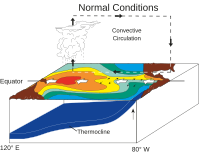
Photo from wikipedia
The ability of six CMIP6 models to reproduce the observed cold season teleconnection between tropical Indo-Pacific sea surface temperatures (SSTs) and precipitation in Southwest Asia, the coastal Middle East (CME),… Click to show full abstract
The ability of six CMIP6 models to reproduce the observed cold season teleconnection between tropical Indo-Pacific sea surface temperatures (SSTs) and precipitation in Southwest Asia, the coastal Middle East (CME), and Northern Pakistan and India (NPI) is examined. The 1979-2014 period is analyzed, to maximize observations over both the tropical ocean and the regions. Nine historical simulations for the same period are examined for each model, to account for the internal variability of the coupled system. The teleconnection is examined in terms of SSTs, precipitation, 200 hPa geopotential heights, and derived quantities.All the models capture some of the broadest features of the teleconnections, but there is a wide range in the ability of the models to reproduce the magnitude and details. The differences appear related to both the models’ ability to capture the details of the tropical variability, including the position and strength of the precipitation anomalies in the Indo-west Pacific, as well as the models’ ability to accurately propagate the tropically-forced response into the region. The teleconnections to the CME and NPI regions on the eastern and western margins, respectively, of the strongest signal are very similar in structure and have similar results, except that the models’ ability to reproduce the strength and details of the teleconnection is even more limited, consistent with their marginal locations and known influence of other modes of variability. For all three areas, the wide range in model ability to capture the leading teleconnection suggests caution in interpreting climate regional projections.
Journal Title: Journal of Climate
Year Published: 2021
Link to full text (if available)
Share on Social Media: Sign Up to like & get
recommendations!